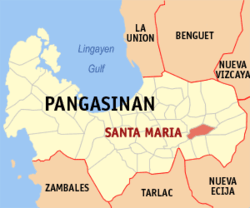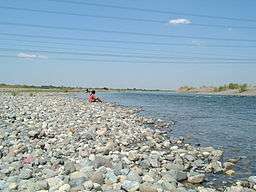Santa Maria, Pangasinan
| Santa Maria | ||
|---|---|---|
| Municipality | ||
| Municipality of Santa Maria | ||
|
| ||
| ||
 Map of Pangasinan with Santa Maria highlighted | ||
.svg.png) Santa Maria Location within the Philippines | ||
| Coordinates: 15°58′51″N 120°42′01″E / 15.98083°N 120.70028°ECoordinates: 15°58′51″N 120°42′01″E / 15.98083°N 120.70028°E | ||
| Country |
| |
| Region | Ilocos Region (Region I) | |
| Province | Pangasinan | |
| District | 6th district of Pangasinan | |
| Barangays | 23 (see Barangays) | |
| Government [1] | ||
| • Type | Sangguniang Bayan | |
| • Mayor | Teodoro Ramos | |
| • Vice Mayor | Condring Ignacio | |
| • Electorate | 19,187 voters (2016) | |
| Area [2] | ||
| • Total | 69.50 km2 (26.83 sq mi) | |
| Population (2015 census)[3] | ||
| • Total | 33,038 | |
| • Density | 480/km2 (1,200/sq mi) | |
| Time zone | UTC+8 (PST) | |
| ZIP code | 2440 | |
| PSGC | 015539000 | |
| IDD : area code | +63 (0)75 | |
| Climate type | Tropical monsoon climate | |
| Income class | 4th municipal income class | |
| Revenue (₱) | 83,358,047.58 (2016)[4] | |
| Poverty incidence | 16.57 (2012)[5] | |
| Native languages |
Pangasinan Ilocano Tagalog | |
| Website |
www | |
Santa Maria, officially the Municipality of Santa Maria, (Pangasinan: Baley na Santa Maria; Ilokano: Ili ti Santa Maria; Tagalog: Bayan ng Santa Maria), is a 4th class municipality in the province of Pangasinan, Philippines. According to the 2015 census, it has a population of 33,038 people.[3]
Barangays
Santa Maria is politically subdivided into 23 barangays.
- Bal-loy
- Bantog
- Caboluan
- Cal-litang
- Capandanan
- Cauplasan
- Dalayap
- Libsong
- Namagbagan
- Paitan
- Pataquid
- Pilar
- Poblacion East
- Poblacion West
- Pugot
- Samon
- San Alejandro
- San Mariano
- San Pablo
- San Patricio
- San Vicente
- Santa Cruz
- Santa Rosa
History
Sta. Maria was formerly a barrio of the municipality of Tayug.
Sta. Maria was founded on January 10, 1855 and was governed by a Captain until 1863. In 1864 Sta. Maria was incorporated into the municipality of Tayug due to Sta. Maria's inability to maintain its financial stability. In 1877 the inhabitants of Sta. Maria applied for separation, as a distinct municipality, from the municipality of Tayug. The application was granted and Sta. Maria, again became a town under the governance of Captain Eugenio Vinluan.
In 1903, the Americans arrived in Sta. Maria and their rule began. In 1901 there was an election for the president of Sta. Maria. This was during the United States military government of the islands. The President was given a two years term, due to his good administration.
Again, in 1903, Sta. Maria was incorporated into the town of Tayug. for financial reasons, as before, but in 1907 a special election was held for the purpose of returning all small municipalities that had incorporated with bigger towns. Don Alejandro Gonzales was then elected president and served until 1910 when he was succeeded by Don Mariano de Guzman who served to 1912. From this date, to the present, the different successions of presidents, alcaldes and mayors had occurred all over the islands.
For many years, during the Spanish Regime, religion was the basis of educating the masses. From time to time missionaries of different orders were sent out to Sta. Maria to carry out religious services as required of them. It was during the routine visit of a certain priest from the town of Asingan, which was then the most eastern town of the province of Pangasinan, who had extended his mission farther into the east and came to a village. The village was located on a plain in which the Agno River ran and which with a little effort could be irrigated. The missionary believed that the village could be developed into a prosperous community. Finding the residents to be hospitable, he chatted with them and, in the course of conversation, he thought of giving the place a name. Since it was the Virgin Mary's Day, he called the people of the village to him and with a simple but impressive solemnity proclaimed this place as Sta. Maria on this, the Virgin Mary's day.
In the course of time prominent people improved the locality and transferred the town site from Namagbagan, which is now a barrio of the municipality, to its present site near a clay promontory where it formed an impregnable defense against the yearly erosion of the Agno, thus annexing "De Pila" to the original name and making Sta. Maria de Pila its final name, a name which is known beyond the confines of the province of Pangasinan.
The town much progressive due to close proximity to Rosales and Tayug.
Demographics
| Population census of Santa Maria | ||
|---|---|---|
| Year | Pop. | ±% p.a. |
| 1903 | 7,628 | — |
| 1918 | 7,362 | −0.24% |
| 1939 | 10,295 | +1.61% |
| 1948 | 12,802 | +2.45% |
| 1960 | 14,230 | +0.89% |
| 1970 | 16,296 | +1.36% |
| 1975 | 18,766 | +2.87% |
| 1980 | 19,018 | +0.27% |
| 1990 | 23,793 | +2.27% |
| 1995 | 25,278 | +1.14% |
| 2000 | 27,860 | +2.11% |
| 2007 | 30,721 | +1.36% |
| 2010 | 31,091 | +0.44% |
| 2015 | 33,038 | +1.16% |
| Source: Philippine Statistics Authority[3][6][7][8] | ||
Climate
| Climate data for Santa Maria, Pangasinan | |||||||||||||
|---|---|---|---|---|---|---|---|---|---|---|---|---|---|
| Month | Jan | Feb | Mar | Apr | May | Jun | Jul | Aug | Sep | Oct | Nov | Dec | Year |
| Average high °C (°F) | 29 (84) |
29 (84) |
30 (86) |
32 (90) |
33 (91) |
33 (91) |
33 (91) |
33 (91) |
33 (91) |
32 (90) |
31 (88) |
29 (84) |
31 (88) |
| Average low °C (°F) | 21 (70) |
21 (70) |
22 (72) |
23 (73) |
24 (75) |
24 (75) |
24 (75) |
24 (75) |
23 (73) |
23 (73) |
22 (72) |
21 (70) |
23 (73) |
| Average precipitation mm (inches) | 127.5 (5.02) |
115.8 (4.559) |
129.7 (5.106) |
141.1 (5.555) |
248.2 (9.772) |
165 (6.5) |
185.3 (7.295) |
161.9 (6.374) |
221.4 (8.717) |
299.5 (11.791) |
199 (7.83) |
188.7 (7.429) |
2,183.1 (85.948) |
| Average rainy days | 17 | 17 | 17 | 15 | 20 | 19 | 19 | 20 | 21 | 20 | 17 | 19 | 221 |
| Source: World Weather Online[9] | |||||||||||||
Image gallery
- Santa Maria Town Hall
- Public Market road to municipal hall and public park
- Public market
 Part of Agno River flowing near Barangay San Vicente, Sta. Maria Pangasinan. A faint image of Narciso Ramos Bridge can be seen at a distance.
Part of Agno River flowing near Barangay San Vicente, Sta. Maria Pangasinan. A faint image of Narciso Ramos Bridge can be seen at a distance.
References
- ↑ "Municipality". Quezon City, Philippines: Department of the Interior and Local Government. Retrieved 31 May 2013.
- ↑ "Province: Pangasinan". PSGC Interactive. Quezon City, Philippines: Philippine Statistics Authority. Retrieved 12 November 2016.
- 1 2 3 Census of Population (2015). "Region I (Ilocos Region)". Total Population by Province, City, Municipality and Barangay. PSA. Retrieved 20 June 2016.
- ↑ "Pangasinan : Cities and Municipalities Competitiveness Index". Makati City, Philippines: National Competitiveness Council (Philippines). Archived from the original on 28 January 2017. Retrieved 28 January 2017.
- ↑ "PSA Releases the 2012 Municipal and City Level Poverty Estimates". Quezon City, Philippines: Philippine Statistics Authority. Archived from the original on 28 January 2017. Retrieved 28 January 2017.
- ↑ Census of Population and Housing (2010). "Region I (Ilocos Region)". Total Population by Province, City, Municipality and Barangay. NSO. Retrieved 29 June 2016.
- ↑ Censuses of Population (1903–2007). "Region I (Ilocos Region)". Table 1. Population Enumerated in Various Censuses by Province/Highly Urbanized City: 1903 to 2007. NSO.
- ↑ "Province of Pangasinan". Municipality Population Data. Local Water Utilities Administration Research Division. Retrieved 17 December 2016.
- ↑ "Santa Maria, Pangasinan: Average Temperatures and Rainfall". World Weather Online. Retrieved 31 October 2015.
External links
| Wikimedia Commons has media related to Santa Maria, Pangasinan. |
- Municipal Profile at the National Competitiveness Council of the Philippines
- Santa Maria at the Pangasinan Government Website
- Local Governance Performance Management System
- Philippine Standard Geographic Code
- Philippine Census Information
- Pangasinan.org : Santa Maria Family and School Reunion Archives
- Official Website of Santa Maria Pangasinan
